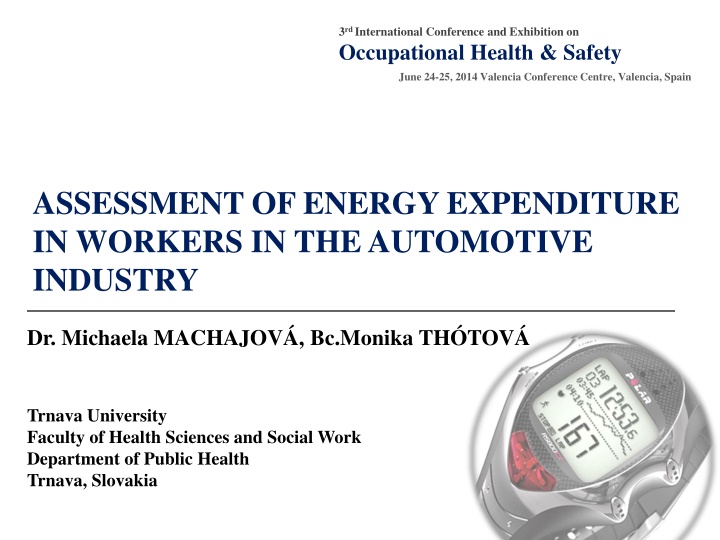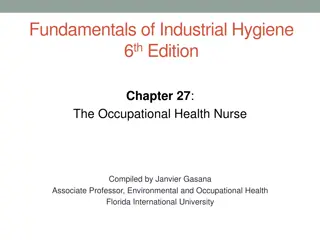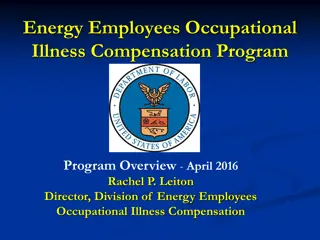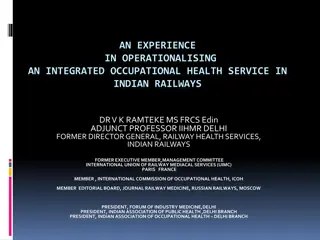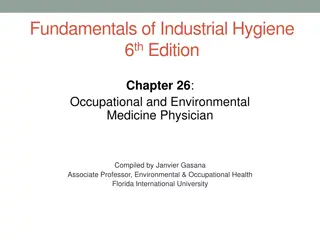Assessment of Energy Expenditure in Automotive Workers: A Study at an International Occupational Health Conference
This study presented at an international occupational health conference in Valencia, Spain, aimed to assess the energy expenditure of workers in the automotive industry. The research involved measuring heart rate and energy consumption using Polar RS 400 devices, comparing results with Slovak regulations, and identifying variations in energy expenditure across different work positions. The study utilized the index method by Borsky to determine energy expenditure levels and analyze differences. Detailed data collection techniques and analysis methods were employed to evaluate the physical strain on workers in various automotive work positions.
Download Presentation

Please find below an Image/Link to download the presentation.
The content on the website is provided AS IS for your information and personal use only. It may not be sold, licensed, or shared on other websites without obtaining consent from the author.If you encounter any issues during the download, it is possible that the publisher has removed the file from their server.
You are allowed to download the files provided on this website for personal or commercial use, subject to the condition that they are used lawfully. All files are the property of their respective owners.
The content on the website is provided AS IS for your information and personal use only. It may not be sold, licensed, or shared on other websites without obtaining consent from the author.
E N D
Presentation Transcript
3rd International Conference and Exhibition on Occupational Health & Safety June 24-25, 2014 Valencia Conference Centre, Valencia, Spain ASSESSMENT OF ENERGY EXPENDITURE IN WORKERS IN THE AUTOMOTIVE INDUSTRY ______________________________________________________ Dr. Michaela MACHAJOV , Bc.Monika TH TOV Trnava University Faculty of Health Sciences and Social Work Department of Public Health Trnava, Slovakia
The main objective To assess energy expenditure of workers during work shift in automobile industry The intermediate objectives 1. To measure heart rate and energy consumption of workers by measurement device Polar RS 400 2. To compare the results with the legal regulations of Slovak Republic 3. To find out the difference in levels of energy expenditure between individual work positions 4. Determine energy expenditure by using index method by Borsky and compare results against measured values Key words: heart rate, energy expenditure, time frame, work load
Hall of coating September December 2013 5 work positions, 20 workers Selection of subjects Inclusion criteria Exclusion criteria Data collection Face to face questionnaire Observation Stalking Instrumental method /Polar RS 400/ Calculation of energetic expenditure Harris Benedict equation Values of index method by Borsky }Time frame
Break HR min HR max 30 min 72 bpm 130 bpm
Table 1 Increase in heart rate and comparison with the permissible values and work position of employees in the age group 30-39 y. Permissible value /bpm/ average Exceeding /bpm/ average Increase HR /bpm/ Work position /sealing/ ID limit limit Left/right side of the floor 1 25 29 32 - - Left/right side of the floor 4 28 29 32 - - Left/right side of the floor 5 38 29 32 9 6 7 8 10 12 13 15 17 Engine compartment 23 29 32 - - Engine compartment 33 29 32 4 1 Tail hood 31 29 32 2 - Engine compartment 39 29 32 10 7 Boot 23 29 32 - - Doors in hinges 29 29 32 - - Doors in hinges 21 29 32 - -
Table 2 Comparison of observed and permissible values of energy expenditure of employees in the age group 30-39 y. Energy expenditure "netto" /kJ/ Permissible value /kJ/ Work position /sealing/ Exceeding /kJ/ ID 1 Left/right side of the floor 6058 7500 - 4 Left/right side of the floor 7585 7500 85 5 Left/right side of the floor 8059 7500 559 7 Engine compartment 3514 7500 - 8 Engine compartment 8433 7500 933 10 Tail hood 6319 7500 - 12 Engine compartment 6171 7500 - 13 Boot 4105 7500 - 15 Doors in hinges 5542 7500 - 17 Doors in hinges 7320 7500 -
Table 3 Comparison of energy expenditure during the work between work positions Energy expenditure of workers /kJ/ Average /kJ/ Work position 8771 5903 4105 8026 6058 7585 8059 5576 5711 3514 8433 6171 5542 4489 7320 5141 3048 6319 5334 3750 Sealing of boot 6701,3 Sealing of left/right side of the floor 6819,5 Sealing of engine compartment 5957,3 Sealing of doors in hinges 5623,0 Sealing of tail hood 4612,8 p NS
Table 4 Time frame and work energy expenditure - sealing left/right side of the floor Total time for work shift /min/ EE2 EE "to /kJ/ Category1 Work operation "from" /kJ/ A stand 81,9 182,7 63 Preparation C medium both upperlimbs 504 630 B walking 80 m/min 13 221 221 102 174 A bend forward 60 Coat sealant 780 1080 C medium both upperlimbs and trunk B walking 80 m/min 13 221 221 A bend forward 321,3 548,1 189 Spread sealant and set out acustic carpet C medium both upperlimbs and trunk 2457 3402 B walking 80 m/min 23 391 391 A stand 89 115,7 115,7 Downtime3 30 Break time 480 5194,9 6965,5 Total Note:1Category by Borsky: A - posture, B - movement (walking), C amount of muscular effort and degree of load;2energy expenditure;3included waiting for car body, failure, extra breaks
Graph 1 Comparison of work energy expenditure by Polar RS 400 and index method by Borsky sealing of left/right side of the floor
Table 5 Comparison of energy expenditure acquired by Polar RS 400 and index method by Borsky Energy expenditure Polar RS 400 /kJ/ 8771 5903 4105 8026 Average 6701,3 6058 7585 8059 5576 Average 6819,5 5711 3514 8433 6171 Average 5957,3 5542 4489 7320 5141 Average 5623,0 3048 6319 5334 3750 Average 4612,8 Energy expenditure Borsky /kJ/ Work position p Sealing of boot 5068,3 6628,7 5848,5 NS Sealing of left/right side of the floor 5194,9 6965,5 6080,2 NS Sealing of engine compartment 4762,8 6550,6 NS 5656,7 Sealing of door in hinges 4573,3 6156,1 5364,7 NS Sealing of tail hood 3007,5 4141,5 3574,5 NS
Small focus group of workers Smoking Body disproportion High- frequency equipment near the measurement device
Increase of heart rate 8 workers /2 x only average value was exceeded/ 3 x sealing of engine compartment Energetic expenditure 4 workers /3 x heart rate was exceeded/ 2 x sealing of left/right side of the floor Comparison - work position Difference was not confirmed Comparison - Polar RS 400/Borsky Difference was not confirmed
